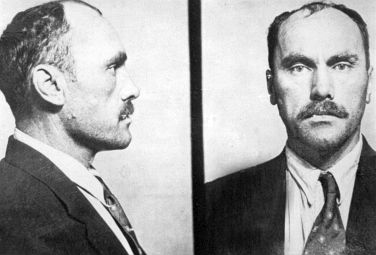|
Carl Panzram (AKA: Jeff Rhodes, John O'Leary) possessed an obsessive hatred for the human race that bordered on the maniacal. This loathing for himself and his fellow man was manifested in a lifetime of murder and mayhem. "I have no desire to reform myself," he said in his published autobiography. "My only desire is to reform people, who try to reform me. I believe that the only way to reform people is to kill them." This human monster was one of the worst criminals in American history.
Panzram was the son of immigrant Prussian farmers. He was born June 28, 1891 on a farm near Warren, Minnesota. His father deserted the family when Panzram was only a boy, leaving a tremendous burden on his over-taxed mother, who had precious little time to give her children. Without the nurturing family environment Carl fell into bad ways. In 1899, he was brought before the juvenile court on a drunk and disorderly charge. He was only eight.
This led to acts of petty thievery, which convinced the courts to send Panzram to the Minnesota State Training School in Red Wing. There, the discipline was rigid, if not sadistic. Carl toiled in workshops from dawn to dusk, and he was often beaten by cruel guards. On the night of July 7, 1905, he set fire to the school warehouse that housed winter blankets and clothing. "That night the whole place burned down at a cost of over $100,000," he later bragged. "Nice, eh?" Carl Panzram left the guilt to others.
Released in January 1906, Panzram launched into his criminal career. On March 29, 1906, he hitched a ride on a west bound freight train at East Grand Forks, North Dakota. He committed a string of robberies and assaults before winding up in the Montana State Reformatory.
After receiving a discharge in 1910, Panzram went to Mexico to join the rebel leader Pascaul Orozco, who served under Venustiano Carranza. He witnessed the wholesale slaughter of prisoners by Orozco during the Mexican revolution, mass murders that conditioned him to his own future killings.
In 1912, Panzram left Mexico and went to California and the Pacific Northwest, where he committed various robberies, assaults, and acts of sodomy. Looking back on his gory career, he would recall with perverted pride: "I have murdered twenty-one human beings. I have committed thousands of burglaries, robberies, larcenies, arson, and last but not least I have committed sodomy on more than 1,000 male human beings."
Panzram was arrested in Chinook, Montana, on a burglary charge and sentenced to a year in the Montana State Prison. He escaped eight months later. Arrested a year later under the alias of "Jeff Rhoades," he was given a two-year sentence in the Montana State Prison on burglary charges, receiving his parole in 1914.
With barely any time to enjoy his freedom, Panzram was arrested in Astoria, Oregon, on a burglary charge and imprisoned in the state prison at Salem for seven years. He constructed his own tools and hacked his way to freedom in May 1918. He then went to Chile as an oil worker, committing crimes in that country before returning to the U.S.
In 1920, Panzram burgled $40,000 in jewels and liberty bonds from the private residence of former president William Howard Taft in New Haven, Connecticut. With this windfall, Panzram purchased a small yacht under the name of "John O'Leary." He used this vessel for rum-running during the early days of Prohibition, but his darkest passion was for burglary. After killing his ten crew members ("so they could never identify me as a bootlegger"), he resumed his house-breaking.
|
 |
 |
 |
| A police photo of serial killer and thief, Carl Panzram, a bestial murderer, who admitted without regret to killing twenty-one persons. |
In 1923, this one-man crime wave was arrested for attempted robbery and sentenced to five years in Sing Sing. The guards at this facility were unable to keep him in line. He was transferred to Clinton Prison in Dannemora, considered to be the end of the line for criminal hard cases.
Released in 1928, Panzram hit the Baltimore-Washington, D. C., area like a tornado, committing eleven burglaries and one murder. He was arrested by Washington, D. C. police on August 16, 1928. While in jail, Panzram wrote his autobiography and gave it to a sympathetic jailer, Henry Lesser. At his trial, Panzram glared at the jurors, chiding them with a deadly threat. "If I live, I'll execute some more of you!" Judge Walter McCoy sentenced the defendant to twenty-five years in Leavenworth. "Visit me!" Panzram shot back.
To the deputy warden at Leavenworth, Fred Zerbst, Panzram issued a grim warning: "I'll kill the first man who bothers me." The following year, on June 20, 1929, Panzram crushed the skull of Robert G. Warnke, killing him with an iron bar. Warnke, a civilian employee working at the prison, had turned in a bad report on Panzram.
Convicted of the Warnke murder, Panzram was sentenced to die on the gallows. When the Society for the Abolishment of Capital Punishment tried to intervene on his behalf, Panzram told them to forget it. Hanging, he said, would be a "real pleasure and a big relief," adding: "the only thanks you or your kind will ever get from me for your efforts on my behalf is that I wish you all had one neck and I had my hands on it...I believe the only way to reform people is to kill 'em...My motto is: `Rob 'em all, rape 'em all and kill 'em all!'"
His last epitaph was signed "Copper John II" in memory of a statue he had seen outside Auburn Prison in New York. Panzram, defiant to the end, was executed in Leavenworth on September 5, 1930. He died as the most unrepentant serial killer in history, cursing the hangman for taking too much time in executing him.
View as a single-column galley proof
View as a feature
|